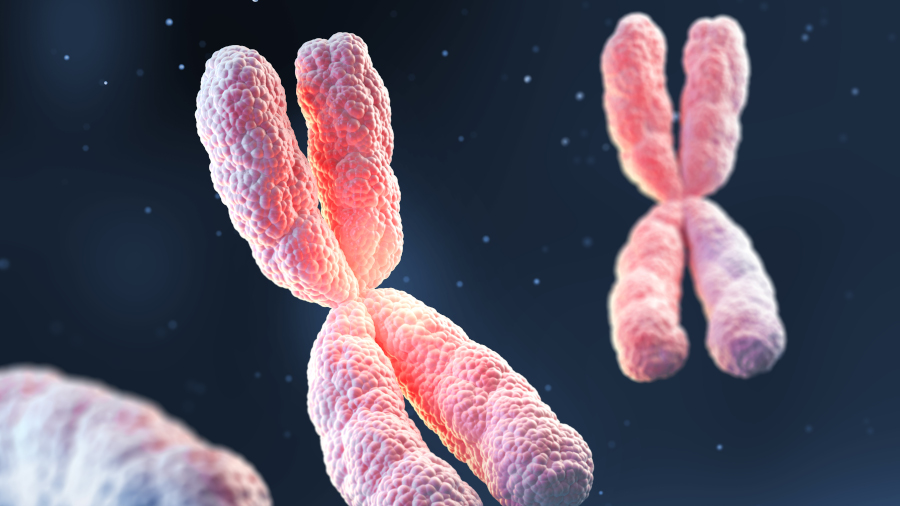Researchers explain the organization of DNA in chromosomes from repetitive interactions between nucleosomes

An article by UAB professor Joan-Ramon Daban analyzes in depth the physical problems associated with DNA packaging that have often been neglected in structural models of chromosomes. The study published in the journal Small Structures demonstrates that the multilaminar organization of DNA, proposed from previous experimental research carried out at the UAB, is fully compatible with the structural and functional properties of chromosomes. This organization can be explained by weak interactions between nucleosomes, which are the repetitive blocks that fold the DNA double helix.
12/09/2024
The multilamellar structure of DNA proposed by the UAB researchers is self-consistent and compatible with the structural and functional properties of chromosomes
The enormously long genomic DNA molecules in eukaryotic organisms must be tightly folded to fit into the micrometric dimensions of the chromosomes compacted during mitosis to protect the genetic information before cell division. Histone proteins were selected early in evolution to transform DNA into chromatin filaments formed by many nucleosomes. The central part of each nucleosome (core particle) is a cylindrical structure (5.7 nanometers height and 11 in diameter) formed by approximately two turns of DNA (147 base pairs) wrapped around an octamer of histones. The understanding of the folding mechanism leading to a high compaction of the chromatin filaments in chromosomes has been a major scientific challenge for decades.
A physically consistent and realistic structural model for DNA organization in chromosomes must be compatible with all the constraints imposed by the observed structural and functional properties of chromosomes. It must be compatible with the high concentration of DNA and the elongated cylindrical shape of chromosomes and the known self-associative properties of chromatin, and also with an effective protection of chromosomal DNA from topological entanglement and mechanical breakage. Unfortunately, these constraints are not considered in different models proposed from the results obtained with diverse experimental techniques and computer modeling studies.
Figure: Relationship between the self-associative properties of nucleosomes at the nanoscale and the micrometric structure of chromosomes. Figure adapted from JR Daban (Small Struct. 2024, 2400203) under the terms of the CC BY 4.0 license.
In the laboratory of professor Joan-Ramon Daban, in the Department of Biochemistry and Molecular Biology at the UAB, researchers had previously used transmission electron microscopy, atomic force microscopy, and cryo-electron tomography techniques and observed that the chromatin emanated from chromosomes prepared in metaphase ionic conditions forms planar multilayer plates, in which each layer has the thickness corresponding to a mononucleosome sheet. Based on these results, the UAB researchers propose that the chromatin filament of the chromosomes folds according to a regular pattern formed by many stacked layers along the axis of the chromosome. This multilayer model is compatible with all the structural constraints considered above. Furthermore, it justifies the geometry of chromosome bands and translocations observed in cytogenetic analyses, and is compatible with feasible physical mechanisms for the control of gene expression, as well as for DNA replication, repair, and segregation to daughter cells.
Chromosomes can be considered as self-organized liquid crystals
Nucleosomes are repetitive building blocks introduced in the monotonous linear structure of double-helical DNA. It has been demonstrated in different laboratories that isolated nucleosome core particles have a high tendency to interact face-to-face forming large columnar structures. Presumably, according to the properties of soft-matter systems, the interplay of these weak anisotropic interactions between nucleosomes and thermal energy could be responsible for the formation of these columnar structures. In the multilayer chromosome model, the repetitive weak interaction between nucleosomes causes the stacking of many chromatin layers. These low energy interactions at the nanoscale justify the self-organization of whole chromosomes, which can be considered lamellar liquid crystals, internally crosslinked by the covalent backbone of a single DNA molecule.
The spontaneous formation of well-defined three-dimensional patterns is in agreement with the contemporary research in nanoscience and nanotechnology that has been obtaining many impressive structures of different sizes, self-assembled from different biological and synthetic repetitive building blocks. Professor Daban considers that molecular biology discovered the self-assembly of diverse biomolecular structures, but at present the research on self-organization of soft-matter systems is being developed mainly in the field of nanotechnology.
The article has been published in the interdisciplinary journal Small Structures, which is interested in microstructures built from nanoparticles, from the point of view of both nanotechnology and life sciences.
Publication:
Joan-Ramon Daban. Rethinking models of DNA organization in micrometer-sized chromosomes from the perspective of the nanoproperties of chromatin favoring a multilayer structure. Small Structures 2024, 2400203. http://doi.org/10.1002/sstr.202400203